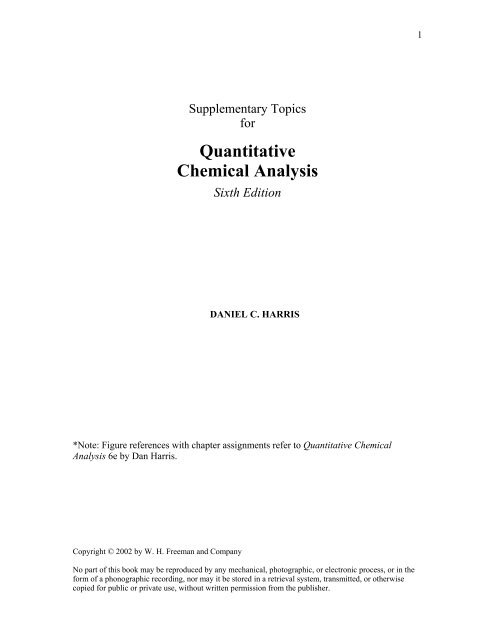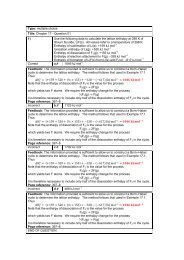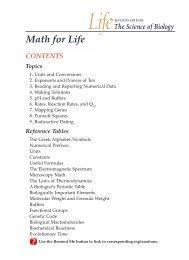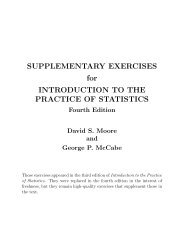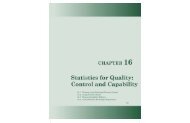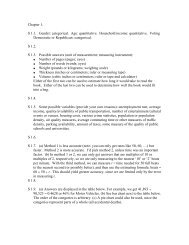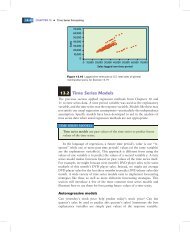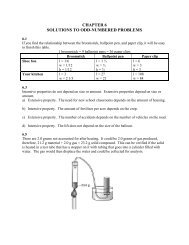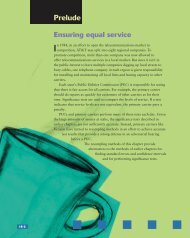Quantitative Chemical Analysis - WH Freeman
Quantitative Chemical Analysis - WH Freeman
Quantitative Chemical Analysis - WH Freeman
You also want an ePaper? Increase the reach of your titles
YUMPU automatically turns print PDFs into web optimized ePapers that Google loves.
1Supplementary Topicsfor<strong>Quantitative</strong><strong>Chemical</strong> <strong>Analysis</strong>Sixth EditionDANIEL C. HARRIS*Note: Figure references with chapter assignments refer to <strong>Quantitative</strong> <strong>Chemical</strong><strong>Analysis</strong> 6e by Dan Harris.Copyright © 2002 by W. H. <strong>Freeman</strong> and CompanyNo part of this book may be reproduced by any mechanical, photographic, or electronic process, or in theform of a phonographic recording, nor may it be stored in a retrieval system, transmitted, or otherwisecopied for public or private use, without written permission from the publisher.
Precipitation Titration of Mixture 2Spreadsheet for PrecipitationTitration of a MixtureWe now derive an equation for the shape of the titration curve for a mixture (initialvolume = V o ) of the anions X - (initial concentration = Co X ) and Y - (initial concentration= Co Y ) titrated with M + (initial concentration = C oM , volume added = V M ) to precipitateMX(s) and MY(s), whose solubility products are KX sp and KY sp . The three mass balancesareMass balance for M: C o . M V M = [M + ](V M + V o ) + mol MX(s) + mol MY(s) (1)Mass balance for X: C Xo . V o = [X - ](V M + V o ) + mol MX(s) (2)Mass balance for Y: C Yo . V o = [Y - ](V M + V o ) + mol MY(s) (3)Equation 2 can be solved for mol MX(s), and Equation 3 can be solved for mol MY(s).When these two expressions are substituted into Equation 1, we can solve for V M to findPrecipitation of X - + Y - with M + :The IF Statement⎛Co V M = V o ⎜ X + Co Y + [M + ] - [X - ] - [Y - ]⎞⎟⎜⎟⎝C oM - [M + ] + [X - ] + [Y - ]⎠(4)Equation 4 allows us to compute the titration curve for a mixture, but we must be awareof some tricky subtleties. For the first part of the titration of a mixture of I - and Cl - , onlyI - is precipitating. In this region, we can say [I - ] = KAgI sp /[Ag + ]. [Cl - ] is just the initialconcentration corrected for dilution ([Cl - ] = C o . Cl {V o /(V M + V o )}), because precipitationof AgCl has not commenced. This is the value computed in column D of the spreadsheetin Figure 1. Precipitation of Cl - begins shortly before the first equivalence point whenthe product [Ag + ][Cl - ] exceeds KAgCl sp .[Cl - ] in Equation 4 must therefore be computed with an IF statement:IF [Ag + ] < KAgCl sp /[Cl - ]then [Cl - ] = C o . Cl {V o /(V M + V o )}otherwise [Cl - ] = KAgCl sp /[Ag + ]A common syntax for testing a logical condition isIF(logic_statement, value_if_true, value_if_false)This expression means that if logic_statement is true, value_if_true is returned.
Precipitation Titration of Mixture 3Otherwise, value_if_false is returned. For example, IF(C2>$A$6, 0.05, 0) returns a valueof 0.05 if C2>$A$6 and a value of 0 if C2≤$A$6. For the titration of I - and Cl - , [Cl - ] incell E4 inA B C D E F G1 Titration of I- + Cl- by Ag+2 [Cl-]3 Ksp(AgCl)= pAg [Ag+] DilutedValue[Cl-] [I-] Vm4 1.80E-10 14.5 3.16E-15 0.0411 4.11E-02 2.62E-02 8.6515 Ksp(AgI)= 14 1.00E-14 0.0344 3.44E-02 8.30E-03 18.0606 8.30E-17 13 1.00E-13 0.0317 3.17E-02 8.30E-04 23.1437 Vo= 12 1.00E-12 0.0314 3.14E-02 8.30E-05 23.7018 40 11 1.00E-11 0.0314 3.14E-02 8.30E-06 23.7579 Co(Cl)= 10 1.00E-10 0.0314 3.14E-02 8.30E-07 23.76310 0.05 9 1.00E-09 0.0314 3.14E-02 8.30E-08 23.76311 Co(I)= 8 1.00E-08 0.0277 1.80E-02 8.30E-09 32.07812 0.0502 7 1.00E-07 0.0234 1.80E-03 8.30E-10 45.60813 Co(Ag)= 6 1.00E-06 0.0229 1.80E-04 8.30E-11 47.24714 0.0845 5 1.00E-05 0.0229 1.80E-05 8.30E-12 47.42415 4 1.00E-04 0.0228 1.80E-06 8.30E-13 47.53416 3 1.00E-03 0.0226 1.80E-07 8.30E-14 48.47917 2 1.00E-02 0.0202 1.80E-08 8.30E-15 59.1681819 C4 = 10^-B420 D4 = $A$10*($A$8/($A$8+G4))21 E4 = If((D4
Precipitation Titration of Mixture 4uses the value in column D. This is called a circular definition. Most spreadsheets allowyou to do this and may question you to see if it is really what you meant to do. The firsttime the value in cell D4 is computed, there is no value in cell G4, so G4=0 is used in cellD4. Then cells E4 and G4 are computed with the value in cell D4. You will need tofollow instructions for your spreadsheet to carry out several iterations to reach selfconsistentvalues in columns D through G.Here is an example of how to get a spreadsheet to accept the circular definition.Unless you have the same spreadsheet that I do, your procedure is probably going to bedifferent and you will need to consult your manual for help. After typing in formulas forthe spreadsheet in Figure 1 in Excel 5 on the Macintosh or Excel 7 on a PC, the values incells D4 through G4 areDiluted Value [Cl-] [I-] Vm0.05 0.05 0.0262469 0Now go to the Tools menu and select Options. In the window that opens, selectCalculations. In the Calculations window, activate Iteration by clicking it. When youclose this window the computer begins to carry out successive approximations to resolvethe circular references and cells D4 through G4 now look like this:Diluted Value [Cl-] [I-] Vm0.04110967 0.0411097 0.0262469 8.6511692We are not quite finished. Near the Iteration command in the Calculations window wasan instruction that said Calc Now (Cmd + =) on the Macintosh. This statement meansthat if you want the spreadsheet to execute more calculations ("calculate now"), press theCommand key and the equals key at the same time. (On the PC the correspondingkeyboard command is F9.) When you do this, the computer does another round ofiteration to refine the numbers in cells D4 through G4. After pressing the keys about 10times, the numbers in these cells stop changing and you have reached the final answeraccurate to the number of decimal places displayed. The final values are:Diluted Value [Cl-] [I-] Vm0.04110872 0.0411087 0.0262469 8.6514727
Precipitation Titration of Mixture 5ExercisesA. Derive Equation 4.B. Prepare a graph with Equation 4 for the titration of 50.00 mL of 0.050 00 M Br - +0.050 00 M Cl - with 0.100 0 M Ag + . Use your spreadsheet to find the fraction ofeach anion precipitated at the first equivalence point. (Answer: 99.723% of Br -and 0.277% of Cl - are precipitated.)C. Derive an expression analogous to Equation 4 for titration of a mixture of threeanions. Compute the shape of the titration curve for 50.00 mL of 0.050 00 M I - +0.050 00 M Br - + 0.050 00 M Cl - with 0.100 0 M Ag + .
Precipitation Titration of Mixture 6Solutions to ExercisesA. From Equation 2, mol MX (s) = C o X Vo - [X - ](V M+ V o )From Equation 3, mol MY (s) = C o Y Vo - [Y - ](V M+ V o )Substituting these into Equation 1 givesC o M V M =[M + ](V M+ V o ) + C o X Vo - [X - ](V M+ V o ) + C o Y Vo - [Y - ](V M+ V o )V M(C o M - [M+ ] + [X - ] + [Y - ]) = V o ([M + ] + C o X - [X- ] + C o Y - [Y- ])which can be rearranged to give Equation 4.B. Titration of 50.00 mL of 0.050 00 M Br - + 0.050 00 M Cl - with 0.100 0 M Ag +A B C D E F G1 Ksp(AgCl) pAg [Ag+] Cl-( Diluted) [Cl-] [Br-] Vm=2 1.8E-10 11 1.00E-11 5.00E-02 5.00E-02 5.00E-02 0.0003 Ksp(AgBr) 10 1.00E-10 3.50E-02 3.50E-02 5.00E-03 21.429=4 5.E-13 9 1.00E-09 3.35E-02 3.35E-02 5.00E-04 24.6275 Vo= 8 1.00E-08 2.95E-02 1.80E-02 5.00E-05 34.7106 50 7 1.00E-07 2.55E-02 1.80E-03 5.00E-06 48.2277 Co(Cl)= 5 1.00E-05 2.50E-02 1.80E-05 5.00E-08 49.9928 0.05 4 1.00E-04 2.50E-02 1.80E-06 5.00E-09 50.0989 Co(Br)= 3 1.00E-03 2.48E-02 1.80E-07 5.00E-10 51.01010 0.05 2 1.00E-02 2.25E-02 1.80E-08 5.00E-11 61.11111 Co(Ag)=12 0.1 Concentrations at first equivalence point:13 (Display more digits to answer question in problem)14 8.266402 5.41E-09 3.333E-02 3.324E-02 9.234E-05 25.0001516 C2 = 10^-B217 D2 = $A$8*($A$6/($A$6+G2))18 E2 = If((D2
Precipitation Titration of Mixture 71110987pAg654321010203040506070Volume (mL)
Precipitation Titration of Mixture 8C. For anions X - , Y - and Z - , the titration equation is⎛Co V M = V o ⎜ X + Co Y + Co Z + [M + ] - [X - ] - [Y - ] - [Z - ]⎞⎟⎜⎟⎝C oM - [M + ] + [X - ] + [Y - ] + [Z - ]⎠Spreadsheet for titration of anions X - , Y - and Z - by Ag +A B C D E F G H I1 Ksp(AgCl) pAg [Ag+] [Cl-] [Cl-] [Br-] [Br-] [I-] Vm2 1.8E-10 (Diluted) (Diluted)3 Ksp(AgBr) 14.77 1.7E-15 5.0E-02 5.0E-02 5.0E-02 5.0E-02 4.9E-02 0.384 5.E-13 14 1.0E-14 3.6E-02 3.6E-02 3.6E-02 3.6E-02 8.3E-03 19.255 Ksp(AgI) 13 1.0E-13 3.4E-02 3.4E-02 3.4E-02 3.4E-02 8.3E-04 24.386 8.3E-17 12 1.0E-12 3.3E-02 3.3E-02 3.3E-02 3.3E-02 8.3E-05 24.947 Vo = 11 1.0E-11 3.3E-02 3.3E-02 3.3E-02 3.3E-02 8.3E-06 24.998 50 10 1.0E-10 2.6E-02 2.6E-02 2.6E-02 5.0E-03 8.3E-07 45.249 Co(Cl) = 9 1.0E-09 2.5E-02 2.5E-02 2.5E-02 5.0E-04 8.3E-08 49.5010 0.05 8 1.0E-08 2.4E-02 1.8E-02 2.4E-02 5.0E-05 8.3E-09 55.8911 Co(Br) = 7 1.0E-07 2.0E-02 1.8E-03 2.0E-02 5.0E-06 8.3E-10 72.7812 0.05 6 1.0E-06 2.0E-02 1.8E-04 2.0E-02 5.0E-07 8.3E-11 74.7813 Co(I) = 5 1.0E-05 2.0E-02 1.8E-05 2.0E-02 5.0E-08 8.3E-12 74.9914 0.05 4 1.0E-04 2.0E-02 1.8E-06 2.0E-02 5.0E-09 8.3E-13 75.1215 Co(Ag) = 3 1.0E-03 2.0E-02 1.8E-07 2.0E-02 5.0E-10 8.3E-14 76.2616 0.1 2 1.0E-02 1.8E-02 1.8E-08 1.8E-02 5.0E-11 8.3E-15 88.891718 C3 = 10^-B3 F3 = $A$12*($A$8/($A$8+I3))19 D3 = $A$10*($A$8/($A$8+I3)) G3 = If((F3
Microequilibrium Constants 11Figure 1. Fractional composition diagram for treatment of 2,3-diphosphoglycerate withbase. Equilibrium among the species is described by microequilibrium constants. [FromCalifornia State Science Fair project of Douglas Harris, 1992.]
Microequilibrium Constants 12ExercisesA. Derive Equations 1 and 2. Also, show that k a k ab = k b k ba . That is, there are onlythree independent microequilibrium constants. If you know three of them, youcan calculate the fourth one.B. Consider the diprotic acid H 2 A, with two chemically distinguishable sites ofprotonation. We define the fraction of protonation at sites a and b as follows:Fraction of protonation at site a = f a =Fraction of protonation at site a = f b =Show thatf a =[H + ] 2 + k b [H + ][H + ] 2 + k b [H + ] + k a [H + ] + k ba k b[H 2 A] + [H a A - ][H 2 A] + [H a A - ] + [H b A - ] + [A 2- ][H 2 A] + [H b A - ][H 2 A] + [H a A - ] + [H b A - ] + [A 2- ][H + ] 2 + k a [H + ]f b =[H + ] 2 + k b [H + ] + k a [H + ] + k ba k bwhere k a , k b , k ab and k ba are microequilibrium constants. In the denominator ofthe f b expression, we made use of the relation k a k ab = k b k ba from the previousproblem.C. (a) Calculate K 1 and K 2 for 2,3-diphosphoglycerate.(b) Using the expressions for f a and f b from the previous problem, calculate thefraction of protonation at each site at pH 7.00.(c) Show that [A 2- ]/[H 2 A] = k ba k b /[H + ] 2 and find this quotient at pH 7.00.Based on this composition, estimate how many equivalents of OH - in Figure1 give pH 7.00.
Microequilibrium Constants 13Solutions to ExercisesA. k a + k b = [H bA 4- ][H + ][H a H b A 3- ]+ [H aA 4- ][H + ][H a H b A 3- ]= ([H aA 4- ] + [H b A 4- ]) [H + ][H a H b A 3- ]= K 1k ab k ba 1k ab + k= ba 1 1=k+ ba k ab1[H a A 4- ][A 5- ][H + ] + [H b A 4- ][A 5- ][H + ]=[A 5- ][H + ][H a A 4- ] + [H b A 4- ]= K 2k a k ab =[H --------- b A 4- ][H + ][H a H b A 3- ][A 5- ][H + ][H --------- b A 4- ]= [H --------- aA 4- ][H + ][H a H b A 3- ][A 5- ][H + ][H --------- a A 4- ]= k b k ba[H 2 A] + [H a A - ]B. f a =[H 2 A] + [H a A - ] + [H b A - ] + [A 2- ]divideeverything=by[H2A]1 + [H aA - ][H 2 A]1 + [H aA - ][H 2 A] + [H bA - ]H 2 A] + [A2- ][H 2 A]But [H a A - ]/[H 2 A] = k b /[H + ], [H b A - ]/[H 2 A] = K a /[H + ], and [A 2- ]/[H 2 A] =k b k ba /[H + ] 2 . Substituting these expressions into the equation above givesf a =1 + k b[H + ]1 + k b[H + ] + k a[H + ] + k bk baThe f b expression is derived similarly.multiplyeverything[H=+ ] + k b [H + ]by [H + ] 2 + k b [H + ] + k a [H + ] + k b k ba[H + ] 2 [H + ] 2C. (a) K 1 = k a + k b = 4.4 × 10 -7 ; K 2 =k ab k bak ab + k ba= 5.0 × 10 -8(b) f a =f b =10 -14 + 1.5 × 10 -1410 -14 + 1.5 × 10 -14 + 2.9 × 10 -14 + 2.25 × 10-14 = 0.3310 -14 + 2.9 × 10 -1410 -14 + 1.5 × 10 -14 + 2.9 × 10 -14 + 2.25 × 10-14 = 0.51(c) [A2- ][H 2 A]= k bak b[H + ] 2 = 2.25. Measurements with a ruler on the graph show that[A 2- ]/[H 2 A] ≈ 2.25 when equivalents of OH - ≈ 1.15.
14Spreadsheets for RedoxTitration CurvesThis section derives equations for calculating titration curves with spreadsheets. Ourgoal is a single equation that describes an entire titration curve with no approximations,except neglect of activity coefficients.Titration with an Oxidizing AgentConsider an oxidizing titrant such as Ce 4+ added to a reducing analyte such as Fe 2+ . LetT be the titrant and A be the analyte, and let the oxidation states change by one electron:T + A → T - + A + (1)titrant analyteThe reduction half-reactions for the two reagents areT + e - T - E = E˚T - 0.059 16 log [T- ][T]A + + e - A E = E Å- 0.059 16 log[A][A + ]For a temperature other than 25°C, the factor 0.059 16 V is really (RT/F) ln 10, where Ris the gas constant, T is temperature in kelvins, and F is the Faraday constant.Now we rearrange the two Nernst equations to find more useful relationshipsbetween the concentrations of reactants and products:E = E˚T - 0.059 16 log [T- ][T]⇒ [T- ][T] = 10(E˚T - E)/0.059 16 ⇒ [T - ] = τ[T] (2)E = E Å- 0.059 16 log[A][A + ]This is τ⇒ [A][A + ] = 10(EÅ - E)/0.059 16 ⇒ [A] = α[A + ] (3)This is αwhere τ ≡ 10 (E˚T - E)/0.059 16 and α ≡ 10 (EÅ - E)/0.059 16 . The letters tau and alpha werechosen as mnemonics for "titrant" and "analyte."Next, we use Equations 2 and 3 and two mass balances to find expressions for theproducts of the titration reaction, [T - ] and [A + ].
Redox Titration Curves 15mass balance for titrant:[T] + [T - ] = T total1τ [T- ] + [T - ] = T total[T - ]( 1 τ + 1) = T total ⇒ [T - ] = τT total1 + τmass balance for analyte: [A] + [A + ] = A total ⇒ [A + ] = A total1 + αTrying to contain our excitement, we carry on, for we have nearly derived amaster equation for the titration. From the stoichiometry of Reaction 1, we know that[T - ] = [A + ], because they are created in a 1:1 mole ratio. Equating [T - ] and [A + ], wefind[T - ] = [A + ]τT total1 + τ= A total1 + α(4)But the fraction of the way (φ) to the equivalence point is just the quotient T total /A total .That is, when the total concentration of T (= [T] + [T - ]) equals the total concentration ofA (= [A] + [A + ]), we are at the equivalence point.fraction of titration:φ = T totalA total(= 1 at equivalence point)If the stoichiometry required, say, 2 mol of T for 3 mol of A, the fraction of titrationwould be φ = 3T total2A, because we demand that φ = 1 at the equivalence point.totalRearranging Equation 4 to solve for the fraction of titration gives the masterequation for the titration curve:Titration with anoxidizing titrant:φ =1 + ττ (1 + α)Equation 5 gives the fraction of titration as a function of the potential, E, which isburied in the numbers τ and α, defined in Equations 2 and 3. The titration curve is agraph of E versus φ. We will compute the curve in the reverse manner by inputtingvalues of E and finding values of φ.Let's amplify what φ means. If the equivalence point of a titration is 50 mL, thenφ = 1 at 50 mL. When 25 mL of titrant has been added, φ = 0.5. When 55 mL of titranthas been added, φ = 1.1. In the spreadsheet approach to redox titration curves, we inputE and compute φ. If we know that the equivalence volume is V e , then we compute thevolume at any point in the titration from the relationship volume = φV e .(5)
Redox Titration Curves 16EXAMPLE Spreadsheet Calculation of the Ce 4+ /Fe 2+ Titration CurveSuppose that we titrate 100.0 mL of 0.050 0 M Fe 2+ with 0.100 M Ce 4+ using the cell inFigure 16-1 of the textbook. V e = 50.0 mL, which means that φ = 1 when V Ce 4+ = 50.0mL. Use Equation 5 to compute the voltages in Figure 16-2 of the textbook for titrantvolumes of 50.0, 36.0, and 63.0 mL.Solution The titration reaction isCe 4+ + Fe 2+ → Ce 3+ + Fe 3+and the half-reactions, written as reductions, areCe 4+ + e - Ce 3+ ⇒ τ = 10 (E˚T - E)/0.059 16 = 10 (1.70 - E)/0.059 16Fe 3+ + e - Fe 2+ ⇒ α = 10 (EÅ - E)/0.059 16 = 10 (0.767 - E)/0.059 16In the spreadsheet in Figure 1, constants in column A are the standard reductionpotentials, the quantity 0.059 16 V in the Nernst equation, and the equivalence volume,50 mL. Values of E (versus S.H.E.) in column B are input to the spreadsheet. ColumnsC and D compute τ and α, and column E calculates φ with Equation 5. Column Fconverts E from the S.H.E. scale to the S.C.E. scale by subtracting 0.241 V. Column Gmultiplies φ by 50 mL to convert the fraction of titration into volume of titrant.To find the voltage for a particular volume of titrant, we vary E in column B untilthe desired volume appears in column G. Rows 12–14 in the spreadsheet computevoltages for 50.0, 36.0, and 63.0 mL.Because titration curves are steep near the equivalence point, we recommendsetting the precision of φ to 12 digits while varying E to search for the equivalence pointpotential. Spreadsheets in this book were generated this way, and then the precision of φwas set back down to a reasonable number to display the results.Equation 5 Applies to Many Oxidation StoichiometriesEquation 5 applies to any titration in which T oxidizes A, providing neitherreagent breaks into smaller fragments or associates into larger molecules. Thestoichiometry of the reaction of T with A need not be 1:1, and there may be any numberof electrons or other species (such as H + and H 2 O) involved in the reaction. Thus,Equation 5 applies to the titration-MnO 4 + 5Fe 2+ + 8H + → Mn 2+ + 5Fe 3+ + 4H 2 Otitrant analyte
Redox Titration Curves 17but not to the titration2-Cr 2 O 7because Cr 2 O 72-titrant+ 6Fe 2+ + 14H + → 2Cr 3+ + 6Fe 3+ + 7H 2 Oanalytebreaks apart into two Cr 3+ ions in the latter reaction. (The dichromatereaction is treated as a special case in Problem I below.A B C E F G1E°(T) = E (vs S.H.E.) Tau Alpha Phi E(vs S.C.E.) Volume (mL)2 1.7 0.600 3.92E+18 6.65E+02 0.00150 0.359 0.0753E°(A) = 0.700 8.00E+16 1.36E+01 0.06864 0.459 3.4324 0.767 0.767 5.90E+15 1.00E+00 0.50000 0.526 25.0005Nernst = 0.800 1.63E+15 2.77E-01 0.78320 0.559 39.1606 0.05916 1.000 6.80E+11 1.15E-04 0.99988 0.759 49.9947Ve = 1.200 2.83E+08 4.80E-08 1.00000 0.959 50.0008 50 1.400 1.18E+05 2.00E-11 1.00001 1.159 50.0009 1.600 4.90E+01 8.31E-15 1.02040 1.359 51.02010 1.700 1.00E+00 1.70E-16 2.00000 1.459 100.0001112 1.2335 7.68E+07 1.30E-08 1.00000 0.993 50.00013 0.79127 2.29E+15 3.89E-01 0.72003 0.550 36.00214 1.66539 3.85E+00 6.52E-16 1.26000 1.424 63.0001516C2 = 10^(($A$2-B2)/$A$6) E2 = (1+C2)/(C2*(1+D2)) G2 = $A$8*E217D2 = 10^(($A$4-B2)/$A$6) F2 = B2-0.241Figure 1. Spreadsheet for titration of Fe 2+ with Ce 4+ based on Equation 5. Column B isthe input and column E is the principal output. The fraction of titration in column E isconverted to volume in column G, and potential (versus S.H.E.) in column B is convertedto potential (versus. S.C.E.) in column F. A titration curve is a graph of column F versuscolumn G.When the Stoichiometry is Not 1:1Suppose that Cu + is titrated with Tl 3+ in 1 M HClO 4 :Tl 3+ + 2Cu + → Tl + + 2Cu 2+titrant analyteThe values of τ and α are computed from the half-reactions:
Redox Titration Curves 18Tl 3+ + 2e - Tl + E = 1.26 -0.059 162log [Tl+ ][Tl 3+ ]⇒ τ ≡ [Tl+ ][Tl 3+] = 102(1.26 - E)/0.059 16 (note 2e - in the exponent) (6)Cu 2+ + e - Cu + E = 0.339 - 0.059 16 log [Cu+ ][Cu 2+ ]⇒ α ≡ [Cu+ ][Cu 2+ ] = 10(0.339 - E)/0.059 16 (7)Combining the mass balances with τ and α leads to the expressions[Tl + ] = τTl total1 + τ[Cu 2+ ] = Cu total1 + αwhere Tl total = [Tl 3+ ] + [Tl + ] and Cu total = [Cu 2+ ] + [Cu + ].Now we know that [Cu 2+ ] = 2[Tl + ], because these products are created in a 2:1mole ratio. Inserting the expressions above for [Tl + ] and [Cu 2+ ] into this equality givesCu total1 + α = 2τTl total1 + τ(8)Because the reaction requires one Tl 3+ for two Cu + ions, the fraction of titration isφ + 2Tl total from Eq. 8Cu= total(1 + τ)τ (1 + α)The factor of 2 appears in the definition of φ because the fraction of titration is defined asunity at the equivalence point. The final result is identical to Equation 5, which wasderived for 1:1 stoichiometry.Adding H + and Other ReactantsNow consider the titration of Tl + by iodate in HCl solution:-IO 3 + 2Tl + + 2Cl - + 6H + → ICl- 2 + 2Tl 3+ + 3H 2 OIodate Thallous Thallic(titrant) (analyte)Thallium is the analyte in this example. Its half-reaction is the same as in the precedingexample, with a formal potential of 0.77 V in 1 M HCl.Tl 3+ + 2e - Tl + E = 0.77 -0.059 162log [Tl+ ][Tl 3+ ]⇒ α ≡ [Tl+ ][Tl 3+ ] = 102(0.77 - E)/0.059 16 (9)The iodate half reaction is more complicated:
Redox Titration Curves 20A B C E F G1E°(T) = E (vs S.H.E.) Tau Alpha Phi E(vs S.C.E.) Volume (mL)2 1.24 0.700 3.24E+36 2.33E+02 0.00428 0.459 0.2143E°(A) = 0.770 6.00E+31 1.00E+00 0.50000 0.529 25.0004 0.77 0.800 5.62E+29 9.68E-02 0.91176 0.559 45.5885Nernst = 0.900 9.74E+22 4.03E-05 0.99996 0.659 49.9986 0.05916 1.083 4.12E+10 2.62E-11 1.00000 0.842 50.0007Ve = 1.200 5.06E+02 2.91E-15 1.00197 0.959 50.0998 50 1.24 1.00E+00 1.29E-16 2.00000 0.999 100.0009pCl =10 0 C2 = 10^(4*($A$2-B2)/$A$6-2*$A$10-6*$A$12)11pH =D2 = 10^(2*($A$4-B2)/$A$6)12 0 E2 = (1+C2)/(C2*(1+D2))13 F2 = B2-0.24114 G2 = $A$8*E2Figure 2. Spreadsheet for titration of Tl + with iodate in Figure 16-3 of the textbook,based on Equation 5. Input in column B is varied to obtain output in column G at anydesired volume. Note that the curve is not symmetric about the equivalence pointbecause the stoichiometry of reactants is not 1:1.
Redox Titration Curves 21Titration with a Reducing AgentFollowing the same reasoning used above, we can show that if a reducing titrant is used,the general equation for the titration curve isTitration withreducing titrant:φ =α (1 + τ)1 + α(11)where τ applies to the titrant and α applies to the analyte.Titration of a MixtureThe titration of two species exhibits two breaks if the standard potentials of the redoxcouples are sufficiently different. Figure 3 shows the theoretical titration curve for anequimolar mixture of Tl + and Sn 2+ titrated with IO- 3 . The two titration reactions arefirst: IO- 3 + 2Sn 2+ + 2Cl - + 6H + → ICl- 2 + 2Sn 4+ + 3H 2 O (12)second: IO- 3 + 2Tl + + 2Cl - + 6H + → ICl- 2 + 2Tl 3+ + 3H 2 O (13)and the relevant half-reactions areIO- 3 + 2Cl- + 6H + + 4e - ICl- 2 + 3H2 O E˚ = 1.24 V⇒ τ ≡ [ICl - 2][IO-= 10 {[4(1.24-E)/0.059 16] - 2 pCl - 6 pH}3]Sn 4+ + 2e - Sn 2+ E˚ = 0.139 V⇒ α 1 ≡ [Sn2+ ][Sn 4+ = 102(0.139 - E)/0.059 16]Tl 3+ + 2e - Tl + E˚ = 0.77 V⇒ α 2 ≡ [Tl+ ][Tl 3+ = 102(0.77 - E)/0.059 16]Because the Sn 4+ | Sn 2+ couple has a lower reduction potential than the Tl 3+ | Tl + couple,Sn 2+ will be oxidized before Tl + . That is, the equilibrium constant for Reaction 12 islarger than for Reaction 13. This is another way of saying that Sn 2+ is a strongerreducing agent than Tl + .To derive an equation for the titration of a mixture, the mass balance equates[ICl- 12 ] to the sum 2 [Sn4+ ] + 1 2 [Tl3+ ], because 1 mol of ICl- 2 is generated for every 2 molof Sn 4+ -and 1 mol of ICl 2 is generated for every 2 mol of Tl 3+ :
Redox Titration Curves 22[ICl 2- ] =12 [Sn4+ ] + 1 2 [Tl3+ ] (14)τI total1 + τ= 1 2 ⎜ ⎛ Sn total⎝ 1 + α ⎠ ⎟⎞ + 1 1 2 ⎜ ⎛ Tl total⎝ 1 + α ⎠ ⎟⎞ 2Titration ofa mixture:φ ≡ 2 ⎜ ⎛ I total⎝ Sn ⎠ ⎟⎞ = 1 + τtotal τ ⎝ ⎜⎛ 1 + Tl total/Sn total1 + α ⎠ ⎟⎞(15)1 1 + α 2⎺↑Factor of 2 appears because 1 mol of-IO 3 reacts with 2 mol of Sn 2+ andφ must be unity at the equivalence pointEquation 15 describes the titration curve in Figure 3. The factors of 1 2 in Equation 14arise from the stoichiometry of reaction of titrant with each analyte. In general, these twofractions will not be 1 2 and will be different from each other. The factor Tl total/Sn totalgives the ratio of moles of analytes in the original solution.Figure 3Theoretical curve for 100.0 mL containing 0.010 0 M Tl + plus 0.010 0 M Sn 2+ titrated-with 0.010 0 M IO 3 , calculated with Equation 15. All solutions contain 1.00 M HCl.
Redox Titration Curves 23ExercisesA. Use a spreadsheet to prepare a titration curve (potential referenced to saturatedcalomel electrode versus volume of titrant) for each case below. Compute thepotential at 0.01V e , 0.5V e , 0.99V e , 0.999V e , V e , 1.01V e , 1.1V e and 2V e .(a) Titration of 25.00 mL of 0.020 0 M Cr 2+ with 0.010 00 M Fe 3+ in 1 MHClO 4 .(b) Titration of 50.0 mL of 0.050 0 M Fe 2+ (E˚ = 0.68 V) with 0.050 0 M MnO- 4at pH 1.00 in H 2 SO 4 .(c) Titration of 50 mL of 0.020 8 M Fe 3+ with 0.017 3 M ascorbic acid at pH1.00 in HCl.2+(d) Titration of 50.0 mL of 0.050 M UO 2 in 1 M HCl with 0.100 M Sn 2+ togive U 4+ and Sn 4+ .B. Use a spreadsheet to prepare a titration curve (potential referenced to saturatedAg | AgCl electrode vs. volume of titrant) for each case below. In addition,compute the potential at the following specific points: 0.01 V e , 0.5 V e , 0.99 V e ,0.999 V e , V e , 1.01 V e , 1.1 V e and 2 V e .(a) Titration of 25.00 mL of 0.020 0 M Fe 3+ with 0.010 00 M Cr 2+ in 1.00 MHClO 4 .(b) Titration of 10.0 mL of 0.0500 M MnO- 4 with 0.050 0 M Fe 2+ at pH -0.30 inH 2 SO 4 .(c) Titration of 50 mL of 0.0208 M Fe 3+ with 0.017 3 M ascorbic acid at pH0.00 in HCl.(d) Titration of 50.0 mL of 0.050 M Sn 2+ 2+in 1 M HCl with 0.100 M UO 2 togive Sn 4+ and U 4+ .C. Set up a spreadsheet to compute the curve for the titration of 100.0 mL of 0.010 0M Tl + with 0.010 0 M IO- 3 . Investigate what happens if the constantconcentration of HCl in both solutions is (a) 0.5, (b) 1.0, and (c) 2.0 M. Assumethat the formal potential of the Tl 3+ | Tl + couple remains at 0.77 V (which is apoor approximation).D. Chromous ion (Cr 2+ ) was titrated with chlorate, ClO 3- , at pH = -0.30 to give Cr 3+and Cl - . The potential was measured with Pt and saturated Ag | AgCl electrodes.(a) Write a balanced half-reaction for ClO 3-→ Cl - .(b) Using just the information below, find E˚ for the ClO 3-half-reaction.
Redox Titration Curves 24ClO 3-+ 6H + + 5e - 12 Cl 2(g) + 3H 2 O E˚ = 1.458 VCl 2 (g) + 2e - 2Cl - E˚ = 1.360 V(c) Compute and graph the titration curve for titrant volume = 0 to volume = 2V e .E. (a) A 100.0-mL solution containing 0.010 0 M Tl + plus 0.010 0 M Sn 2+ in 1.00-M HCl was titrated with 0.010 0 M IO 3 containing 1.00 M HCl. Prepare aspreadsheet to find the potential when 20.0, 25.0, 50.0, 60.0, 75.0, 100.0, and110.0 mL of titrant has been added.(b) Prepare a spreadsheet for the titration in (a) if the concentrations are changedto 5.00 mM Tl + and 15.0 mM Sn 2+ . Find the potential at the followingvolumes: 20.0, 37.5, 74.0, 75.0, 76.0, 87.5, 100.0 and 110.0 mL.F. A 25.0-mL solution containing a mixture of U 4+ and Fe 2+ in 1 M HClO 4 wastitrated with 0.009 87 M KMnO 4 in 1 M HClO 4 .(a) Write balanced equations for the two titration reactions in the order in whichthey occur.(b) Potentiometric end points were observed at 12.73 and 31.21 mL. Calculatethe molarities of U 4+ and Fe 2+ in the unknown.(c) Defining the fraction of titration, φ, such that φ = 1 at the first equivalencepoint, show thatφ = 5 Mn total2 U= ⎜ ⎛ 1 + τtotal ⎝ τ ⎠ ⎟⎞ ⎝ ⎜⎛ 1 + 1 Fe total /U total1 + α ⎠ ⎟⎞1 2 1 + α 2where α 1 refers to U 4+ and α 2 refers to Fe 2+ .(d) Calculate the potential (versus S.H.E.) at 1 2 V e1, V e1 , V e1 + 1 2 V e2 (= 21.97mL), and V e2 (= 31.21 mL), where V e1 and V e2 are the two equivalencevolumes.(e) Graph the titration curve up to 50 mL.G. Consider the titration of analytes A and B by 1.00 M oxidizing titrant T:T(aq) + 3e - T 3- (aq) E˚T = 0.93 V⇒ τ = [T3- ][T]= 103(0.93 - E)/0.059 16A 2+ (aq) + 2e - A(aq) E Å = -0.13 V⇒ α =[A][A 2+ ]= 102(-0.13 - E)/0.059 16B + (aq) + e - B(aq) E˚B = 0.46 V
Redox Titration Curves 25⇒ β = [B][B + ]= 10 (0.46 - E)/0.059 16The initial volume of 100.0 mL contains 0.300 M A and 0.060 0 M B.(a) Write the two titration reactions in the order in which they occur. Calculatethe equilibrium constant for each one.(b) Find the two equivalence volumes, designated V e1 and V e2 .(c) Defining the fraction of titration (φ) to be unity at the first equivalence point,show thatφ = 3 T total2 A= ⎜ ⎛ 1 + τtotal ⎝ τ ⎠ ⎟⎞ ⎝ ⎜⎛ 11 + α + 1 B total /A total2 1 + β ⎠ ⎟⎞(d) Use a spreadsheet to prepare a graph of the titration curve (E versus S.H.E.).(e) What are the potentials at the two equivalence points? Use 12 decimal placesfor V e to obtain 3 digits for the equivalence point potential.H. Suppose that 100.0 mL of solution containing 0.100 M Fe 2+ and 5.00 × 10 -5 Mtris (1,10-phenanthroline)Fe(II) (ferroin) is titrated with 0.050 0 M Ce 4+ in 1 MHClO 4 . Calculate the potential (versus S.H.E.) at the following volumes of Ce 4+and prepare a graph of the titration curve: 1.0, 10.0, 100.0, 190.0, 199.0, 200.0,200.05, 200.10, 200.15, 200.2, 201.0, and 210.0 mL. Is ferroin a suitableindicator for the titration?I. Derivation of Spreadsheet Equation for Dichromate Titrations. Consider thetitration of 120.0 mL of 0.0100 M Fe 2+ by 0.0200 M dichromate at pH = 1.00:2-Cr 2 O 7 + 6Fe 2+ + 14H + → 2Cr 3+ + 6Fe 3+ + 7H 2 OTitrant AnalyteThe half-reaction for analyte is Fe 3+ + e - Fe 2+ E˚ = 0.771 V⇒ α = [Fe2+ ][Fe 3+ ]= 10 (0.771 - E)/0.059 16[Fe 3+ ] = Fe total /(1+α).The half-reaction for titrant is more complicated:2-Cr 2 O 7 + 14H + + 6e - 2Cr 3+ + 7H 2 O E˚ = 1.36 V⇒ τ ≡E = E˚ -0.059 166[Crlog3+ ] 22-[Cr 2 O 7 ][H + ] 14[Cr 3+ ] 22- = 10 {6(1.36 - E)/0.059 16 - 14pH}[Cr 2 O 7 ]⇒ [Cr 2 O 72- ] =1τ [Cr3+ ] 2The mass balance for chromium is
Redox Titration Curves 26Cr total = [Cr 3+ ] + 2[Cr 2 O 72- ] = [Cr 3+ ] + 2 τ [Cr3+ ] 2⇒ Cr total = [Cr 3+ ] ⎜ ⎛ τ + 2[Cr 3+ ]⎝ τ ⎠ ⎟⎞⇒ [Cr 3+ ] = Cr total ⎜ ⎛ τ⎝ τ + 2[Cr 3+ ] ⎠ ⎟⎞(B)Quadratic equation A can be solved for [Cr 3+ ] and we find the positive root to be[Cr 3+ ] =- τ 2 + τ 24 + 2τCr total2Since Fe 3+ and Cr 3+ are created in 6:2 proportions, we can say that3[Cr 3+ ] = [Fe 3+ ]Substituting [Cr 3+ ] from Equation B and [Fe 3+ ] = Fe total /(1+α) gives3 Cr total ⎜ ⎛ τ⎝ τ + 2[Cr 3+ ] ⎠ ⎟⎞= Fe total(1 + α)The fraction of titration for the reaction is φ = 3Cr total /Fe total . The factor of 3guarantees that φ = 1 at the equivalence point. Rearranging the equation abovegivesφ = 3 Cr totalFe= τ + 2[Cr3+ ]total τ (1 + α)Replacing [Cr 3+ ] by its value from Equation C gives what we seek:(A)(C)φ = 3 Cr totalFe total=12 + 14 + 2Cr totalτ1 + α(D)But the value of φ depends on the total concentration of chromium at each point.We can express the total concentration of chromium in terms of φ as follows:Cr total =mmol of CrmL of solution= V Cr C CrV Cr + V Fe ˚=φ V e C Crφ V e + V Fe ˚2-where C Cr is the concentration of chromium (= 2[Cr 2 O 7 ]) in titrant and VFe ˚ isthe initial concentration of Fe 2+ analyte. Substituting Cr total from Equation E intoEquation D gives the master equation for the titration curve of Fe 2+ titrated with2-Cr 2 O 7 :(E)φ = 3 Cr totalFe total=12 + 14 + 2 φ V e C Crτ φ V e + τ V Fe ˚1 + α(F)To implement Equation F on a spreadsheet, the constants C Cr and V Fe ˚ are
Redox Titration Curves 27added to column A. A value of potential (vs S.H.E.) is inserted in column B andvalues of τ and α are computed in columns C and D. Equation F is used tocompute φ in column E. In this formula, φ is defined in terms of itself. We callthis a circular definition. The spreadsheet uses successive approximations to finda solution. The end of the section "Spreadsheet for Precipitation Titration of aMixture" in this supplement explains how to handle a circular definition in aspreadsheet.Consider the titration of 120.0 mL of 0.010 0 M Fe 2+ (buffered to pH1.00) with 0.020 M Cr 2 O2- 7 monitored by Pt and saturated Ag | AgCl electrodes.Use a spreadsheet to prepare a graph of the titration curve. Report the potential atthe following volumes of Cr 2 O2- 7 : 0.100, 2.00, 4.00, 6.00, 8.00, 9.00, 9.90,10.00, 10.10, 11.00, 12.00 mL.
Redox Titration Curves 28Solutions to ExercisesA. (a) Titration reaction: Cr 2+ + Fe 3+ → Fe 2+ + Cr 3+Titrant: Fe 3+ + e - Fe 2+ E˚ = 0.767 VAnalyte: Cr 3+ + e - Cr 2+ E˚ = -0.42 Vτ = 10 (0.767 - E)/0.059 16 α = 10 (-0.42 - E)/0.059 16(1 + τ)φ =τ (1 + α)V e = 50.0 mLSpreadsheet for titration of Cr 2+ with Fe 3+A B C D E F G1 E°(T) = E (vs S.H.E.) Tau Alpha Phi E (vs S.C.E.) Volume(mL)2 0.767 -0.538 1.15E+22 9.88E+01 0.01002 -0.779 0.5013 E°(A) = -0.420 1.16E+20 1.00E+00 0.50000 -0.661 25.0004 -0.42 -0.302 1.17E+18 1.01E-02 0.98998 -0.543 49.4995 Nernst = -0.242 1.14E+17 9.80E-04 0.99902 -0.483 49.9516 0.05916 0.174 1.06E+10 9.11E-11 1.00000 -0.067 50.0007 Ve = 0.649 9.88E+01 8.52E-19 1.01013 0.408 50.5068 50 0.708 9.94E+00 8.57E-20 1.10062 0.467 55.0319 0.767 1.00E+00 8.63E-21 2.00000 0.526 100.0001011 C2 = 10^(($A$2-B2)/$A$6) E2 = (1+C2)/(C2*(1+D2))12 D2 = 10^(($A$4-B2)/$A$6) F2 = B2-0.241 G2 = $A$8*E2(b) Titration reaction: 5Fe 2+ + MnO 4- + 8H + → 5Fe 3+ + Mn 2+ + 4H 2 OTitrant: MnO- 4 + 8H + + 5e - → Mn 2+ + 4H 2 O E˚ = 1.507 VAnalyte: Fe 3+ + e - Fe 2+ E˚ = 0.68 Vτ = 10 {[5(1.507 - E)/0.059 16] - 8 pH} α = 10 (0.68 - E)/0.059 16(1 + τ)φ =τ (1 + α)V e = 10.0 mL
Redox Titration Curves 29Spreadsheet for titration of Fe 2+ with permanganateA B C D E F G1 E°(T) = E (vs S.H.E.) Tau Alpha Phi E (vs S.C.E.) Volume(mL)2 1.507 0.562 7.38E+71 9.88E+01 0.01002 0.321 0.1003 E°(A) = 0.680 7.86E+61 1.00E+00 0.50000 0.439 5.0004 0.68 0.798 8.36E+51 1.01E-02 0.98998 0.557 9.9005 Nernst = 0.858 7.10E+46 9.80E-04 0.99902 0.617 9.9906 0.05916 1.290 2.19E+10 4.89E-11 1.00000 1.049 10.0007 Ve = 1.389 9.40E+01 1.04E-12 1.01064 1.148 10.1068 10 1.400 1.10E+01 6.75E-13 1.09052 1.159 10.9059 pH = 1.412 1.07E+00 4.23E-13 1.93525 1.171 19.35210 111 C2 = 10^(5*($A$2-B2)/$A$6-8*$A$10) E2 = (1+C2)/(C2*(1+D2))12 D2 = 10^(($A$4-B2)/$A$6) F2 = B2-0.241 G2 = $A$8*E2(c) Titration reaction: ascorbic acid + 2Fe 3+ + H 2 O → dehydro. + 2Fe 2+ + 2H +Titrant: dehydro. + 2H + + 2e - → ascorbic acid + H 2 O E˚ = 0.390 VAnalyte: Fe 3+ + e - Fe 2+ E˚ = 0.732 Vτ = 10 {[2(0.390 - E)/0.059 16] - 2 pH} α = 10 (0.732 - E)/0.059 16α (1 + τ)φ =(1 + α)V e = 30.0 6 mLSpreadsheet for titration of Fe 3+ with ascorbic acidA B C D E F G1 E°(T) = E (vs S.H.E.) Tau Alpha Phi E (vs S.C.E.) Volume(mL)2 0.39 0.850 2.81E-18 1.01E-02 0.01002 0.609 0.3013 E°(A) = 0.732 2.74E-14 1.00E+00 0.50000 0.491 15.0304 0.732 0.614 2.67E-10 9.88E+01 0.98998 0.373 29.7595 Nernst = 0.555 2.64E-08 9.81E+02 0.99898 0.314 30.0296 0.05916 0.464 3.15E-05 3.39E+04 1.00000 0.223 30.0607 Ve = 0.390 1.00E-02 6.04E+05 1.01000 0.149 30.3618 30.06 0.360 1.03E-01 1.94E+06 1.10332 0.119 33.1669 pH = 0.331 9.88E-01 6.00E+06 1.98762 0.090 59.74810 111 C2 = 10^(2*($A$2-B2)/$A$6-2*$A$10) E2 = D2*(1+C2)/(1+D2)12 D2 = 10^(($A$4-B2)/$A$6) F2 = B2-0.241 G2 = $A$8*E2(d) Titration reaction: UO2+ 2 + Sn 2+ + 4H + → U 4+ + Sn 4+ + 2H 2 OTitrant: Sn 4+ + 2e - Sn 2+ E˚ = 0.139 VAnalyte: UO2+ 2 + 4H + + 2e - → U 4+ + 2H 2 O E˚ = 0.273 Vτ = 10 [2(0.139 - E)/0.059 16]αα (1 + τ)φ =(1 + α)= 10 {2(0.273 - E)/0.059 16 - 4 pH}V e = 25.0 mL
Redox Titration Curves 30Spreadsheet for titration of UO2+ 2 with Sn 2+A B C D E F G1 E°(T) = E (vs S.H.E.) Tau Alpha Phi E (vs S.C.E.) Volume(mL)2 0.139 0.332 2.99E-07 1.01E-02 0.01002 0.091 0.2513 E°(A) = 0.301 3.34E-06 1.13E-01 0.10160 0.060 2.5404 0.273 0.216 2.49E-03 8.45E+01 0.99077 -0.025 24.7695 Nernst = 0.207 5.03E-03 1.70E+02 0.99916 -0.034 24.9796 0.05916 0.206 5.43E-03 1.84E+02 1.00000 -0.035 25.0007 Ve = 0.195 1.28E-02 4.33E+02 1.01046 -0.046 25.2618 25 0.169 9.68E-02 3.28E+03 1.09645 -0.072 27.4119 pH = 0.139 1.00E+00 3.39E+04 1.99994 -0.102 49.99910 011 C2 = 10^(2*($A$2-B2)/$A$6-4*$A$10) E2 = D2*(1+C2)/(1+D2)12 D2 = 10^(2*($A$4-B2)/$A$6) F2 = B2-0.241 G2 = $A$8*E2B. (a) Titration reaction: Cr 2+ + Fe 3+ → Fe 2+ + Cr 3+Titrant: Cr 3+ + e - Cr 2+ E˚ = -0.42 VAnalyte: Fe 3+ + e - Fe 2+ E˚ = 0.767 Vτ = 10 (-0.42 - E)/0.059 16 α = 10 (0.767 - E)/0.059 16α (1 + τ)φ =(1 + α)V e = 50.0 mLSpreadsheet for titration of Fe 3+ with Cr 2+A B C D E F G1 E°(T) = E (vs S.H.E.) Tau Alpha Phi E(vs Ag|AgCl) Volume(mL)2 -0.42 0.885 8.73E-23 1.01E-02 0.01002 0.688 0.5013 E°(A) = 0.767 8.63E-21 1.00E+00 0.50000 0.570 25.0004 0.767 0.649 8.52E-19 9.88E+01 0.98998 0.452 49.4995 Nernst = 0.590 8.47E-18 9.81E+02 0.99898 0.393 49.9496 0.05916 0.174 9.11E-11 1.06E+10 1.00000 -0.023 50.0007 Ve = -0.302 1.01E-02 1.17E+18 1.01013 -0.499 50.5068 50 -0.361 1.01E-01 1.17E+19 1.10062 -0.558 55.0319 -0.420 1.00E+00 1.16E+20 2.00000 -0.617 100.0001011 C2 = 10^(($A$2-B2)/$A$6) E2 = D2*(1+C2)/(1+D2)12 D2 = 10^(($A$4-B2)/$A$6) F2 = B2-0.197 G2 = $A$8*E2(b) Titration reaction: 5Fe 2+ + MnO 4- + 8H + → 5Fe 3+ + Mn 2+ + 4H 2 OTitrant: Fe 3+ + e - Fe 2+ E˚ = 0.68 V-Analyte: MnO 4 + 8H + + 5e - → Mn 2+ + 4H 2 OE˚ = 1.507 Vτ = 10 (0.68 - E)/0.059 16αα (1 + τ)φ =(1 + α)= 10 {[5(1.507 - E)/0.059 16] - 8 pH}V e = 50.0 mL
Redox Titration Curves 31Spreadsheet for titration of permanganate with Fe 2+A B C D E F G1 E°(T) = E (vs S.H.E.) Tau Alpha Phi E(vs Ag|AgCl) Volume(mL)2 0.68 1.559 1.39E-15 1.01E-02 0.01002 1.362 0.5013 E°(A) = 1.535 3.53E-15 1.08E+00 0.51930 1.338 25.9654 1.507 1.512 8.64E-15 9.49E+01 0.98958 1.315 49.4795 Nernst = 1.499 1.43E-14 1.19E+03 0.99916 1.302 49.9586 0.05916 1.390 9.97E-13 1.94E+12 1.00000 1.193 50.0007 Ve = 0.798 1.01E-02 2.10E+62 1.01013 0.601 50.5068 50 0.739 1.01E-01 2.04E+67 1.10062 0.542 55.0319 pH = 0.680 1.00E+00 1.97E+72 2.00000 0.483 100.00010 -0.311 C2 = 10^(($A$2-B2)/$A$6) F2 = B2-0.197 G2 = $A$8*E212 D2 = 10^(5*($A$4-B2)/$A$6-8*$A$10) E2 = D2*(1+C2)/(1+D2)(c) Titration reaction: dehydro. + 2Fe 2+ + 2H + → ascorbic acid + 2Fe 3+ + H 2 OTitrant: dehydro. + 2H + + 2e - → ascorbic acid + H 2 OE˚ = 0.390 VAnalyte: Fe 3+ + e - Fe 2+ E˚ = 0.732 Vτ = 10 {[2(0.390 - E)/0.059 16] - 2 pH} α = 10 (0.732 - E)/0.059 16φ =α (1 + τ)(1 + α)V e = 30.0 6 mLSpreadsheet for titration of Fe 3+ with ascorbic acidA B C D E F G1 E°(T) = E (vs S.H.E.) Tau Alpha Phi E(vs Ag|AgCl) Volume(mL)2 0.39 0.850 2.81E-16 1.01E-02 0.01002 0.653 0.3013 E°(A) = 0.732 2.74E-12 1.00E+00 0.50000 0.535 15.0304 0.732 0.614 2.67E-08 9.88E+01 0.98998 0.417 29.7595 Nernst = 0.554 2.86E-06 1.02E+03 0.99902 0.357 30.0316 0.05916 0.504 1.40E-04 7.14E+03 1.00000 0.307 30.0607 Ve = 0.449 1.01E-02 6.08E+04 1.01011 0.252 30.3648 30.06 0.420 9.68E-02 1.88E+05 1.09678 0.223 32.9699 pH = 0.390 1.00E+00 6.04E+05 2.00000 0.149 60.12010 011 C2 = 10^(2*($A$2-B2)/$A$6-2*$A$10) E2 = D2*(1+C2)/(1+D2)12 D2 = 10^(($A$4-B2)/$A$6) F2 = B2-0.197 G2 = $A$8*E2(d) Titration reaction: UO2+ 2 + Sn 2+ + 4H + → U 4+ + Sn 4+ + 2H 2 OTitrant: UO2+ 2 + 4H + + 2e - → U 4+ + 2H 2 O E˚ = 0.273 VAnalyte: Sn 4+ + 2e - Sn 2+ E˚ = 0.139 Vτ = 10 {2(0.273 - E)/0.059 16 - 4 pH} α = 10 [2(0.139 - E)/0.059 16]
Redox Titration Curves 32φ =(1 + τ)τ (1 + α)V e = 25.0 mLSpreadsheet for titration of Sn 2+ with UO2+2C.A B C D E F G1 E°(T) = E (vs S.H.E.) Tau Alpha Phi E(vs Ag|AgCl) Volume(mL)2 0.273 0.080 3.35E+06 9.88E+01 0.01002 -0.117 0.2513 E°(A) = 0.139 3.39E+04 1.00E+00 0.50001 -0.058 12.5004 0.139 0.195 4.33E+02 1.28E-02 0.98965 -0.002 24.7415 Nernst = 0.205 1.99E+02 5.87E-03 0.99916 0.008 24.9796 0.05916 0.206 1.84E+02 5.43E-03 1.00000 0.009 25.0007 Ve = 0.217 7.82E+01 2.31E-03 1.01046 0.020 25.2618 25 0.243 1.03E+01 3.05E-04 1.09645 0.046 27.4119 pH = 0.273 1.00E+00 2.95E-05 1.99994 0.076 49.99910 011 C2 = 10^(2*($A$2-B2)/$A$6-4*$A$10) E2 = (1+C2)/(C2*(1+D2))12 D2 = 10^(2*($A$4-B2)/$A$6) F2 = B2-0.197 G2 = $A$8*E2D. (a) Balanced reaction: ClO 3- + 6H + + 6e - Cl - + 3H 2 O(b) ClO- 3 + 6H + + 5e - 1→ 2 Cl 2 + 3H 2 O ∆G 1˚ = -5F(1.458)12 Cl 2 + e - → Cl - ∆G 2˚ = -1F(1.360)ClO 3- + 6H + + 6e -Cl - + 3H 2 O ∆G 3˚ = ∆G 1˚ + ∆G 2˚ = -6FE 3˚-6FE 3˚ = -5F (1.458) - F (1.360) ⇒ E 3˚ = 1.442 V(c) Titration reaction: ClO- 3 + 6H + + 6Cr 2+ Cl - + 6Cr 3+ + 3H 2 OTitrant: ClO- 3 + 6H + + 6e - Cl - + 3H 2 O E˚ = 1.442 V
Redox Titration Curves 33Analyte: Cr 3+ + e - Cr 2+ E˚ = -0.42 Vτ = 10 {[6(1.442 - E)/0.059 16] - 6 pH} α = 10 (-0.42 - E)/0.059 16(1 + τ)φ =τ (1 + α)E (vs Ag|AgCl)1.61.20.80.40.0-0.4-0.80.00.5 1.0 1.5Fraction of titration2.0E. (a) Spreadsheet for titration of Tl + + Sn 2+ with iodateA B C D E F G H1 E°(T) = E (SHE) Tau Alpha1 Alpha2 Phi E(SCE) Volume2 1.24 0.134 6.0E+74 1.5E+00 3.2E+21 0.4039 -0.107 20.1953 E°(A1) = 0.139 2.8E+74 1.0E+00 2.1E+21 0.5000 -0.102 25.0004 0.139 0.454 1.4E+53 2.2E-11 4.8E+10 1.0000 0.213 50.0005 E°(A2) = 0.752 9.9E+32 1.9E-21 4.1E+00 1.1976 0.511 59.8826 0.77 0.770 6.0E+31 4.7E-22 1.0E+00 1.5000 0.529 75.0007 Nernst = 1.080 6.6E+10 1.5E-32 3.3E-11 2.0000 0.839 100.0008 0.05916 1.225 1.0E+01 1.9E-37 4.1E-16 2.1936 0.984 109.6789 Ve =10 5011 pCl = C2 = 10^(4*($A$2-B2)/$A$8-2*$A$12-6*$A$14)12 0 D2 = 10^(2*($A$4-B2)/$A$8)13 pH = E2 = 10^(2*($A$6-B2)/$A$8)14 0 F2 = ((1+C2)/C2)*((1/(1+D2))+(($A$16/$A$18)/(1+E2)))15 Tl(total)= G2 = B2-0.24116 0.01 H2 = $A$10*F217 Sn(total)=18 0.01
Redox Titration Curves 34(b) Titration of Tl + and Sn 2+ with iodateA B C D E F G H1 E°(T) = E (S.H.E.) Tau Alpha1 Alpha2 Phi E(S.C.E.) Volume2 1.24 0.126 2.1E+75 2.8E+00 5.9E+21 0.27 -0.115 19.9953 E°(A1) = 0.139 2.8E+74 1.0E+00 2.1E+21 0.50 -0.102 37.5004 0.139 0.194 5.3E+70 1.4E-02 3.0E+19 0.99 -0.047 73.9775 E°(A2) = 0.462 4.0E+52 1.2E-11 2.6E+10 1.00 0.221 75.0006 0.77 0.729 3.6E+34 1.1E-20 2.4E+01 1.01 0.488 75.9877 Nernst = 0.770 6.0E+31 4.7E-22 1.0E+00 1.17 0.529 87.5008 0.05916 1.077 1.0E+11 1.9E-32 4.2E-11 1.33 0.836 100.0009 Ve = 1.226 8.8E+00 1.8E-37 3.8E-16 1.48 0.985 111.30910 7511 pCl =12 0 C2 = 10^(4*($A$2-B2)/$A$8-2*$A$12-6*$A$14)13 pH = D2 = 10^(2*($A$4-B2)/$A$8)14 0 E2 = 10^(2*($A$6-B2)/$A$8)15 Tl(total)= F2 = ((1+C2)/C2)*((1/(1+D2))+(($A$16/$A$18)/(1+E2)))16 0.005 G2 = B2-0.24117 Sn(total)= H2 = $A$10*F218 0.015F. Titrant: MnO- 4 + 8H + + 5e - Mn 2+ + 4H 2 O E˚ = 1.507 Vτ = 10 {[5(1.507 - E)/0.059 16] - 8 pH}First analyte: UO2+ 2 + 4H + + 2e - U 4+ + 2H 2 O E˚ = 0.273 Vα 1 = 10 {2(0.273 - E)/0.059 16 - 4 pH}Second analyte: Fe 3+ + e - Fe 2+ E˚ = 0.767 Vα 2 = 10 (0.767 - E)/0.059 16(a) First reaction: 2MnO- 4 + 5U 4+ + 2H 2 O → 2Mn 2+ + 5UO2+ 2 + 4H +Second reaction: MnO- 4 + 8H + + 5Fe 2+ → Mn 2+ + 5Fe 3+ + 4H 2 O(b) [U 4+ ] = 5 2 ⎝ ⎜⎛ mmol MnO- 425.0 mL ⎠ ⎟⎞ = 5 2 ⎝ ⎜⎛ 12.73 mL × 0.009 87 M25.0 mL ⎠ ⎟⎞ = 0.012 5 6 M[Fe 2+ ] = 5 ⎜ ⎛ mmol MnO- 4⎝ 25.0 mL ⎠ ⎟⎞ = 5 ⎜ ⎛ (31.21-12.73) mL × 0.009 87 M⎝ 25.0 mL ⎠ ⎟⎞ = 0.036 4 8 M(c) From the stoichiometry of the two reactions, we know that[Mn 2+ ] = 2 5 [UO2+ 2 ] + 1 5 [Fe3+ ]τMn total= 2 U total1 + τ 5+ 1 Fe total1 + α 1 5 1 + α 2φ ≡ 5 Mn total2 U= ⎜ ⎛ 1 + τtotal ⎝ τ ⎠ ⎟⎞ ⎝ ⎜⎛ 1 + 1 Fe total /U total1 + α ⎠ ⎟⎞1 2 1 + α 2
Redox Titration Curves 35(d) Titration of U 4+ + Fe 2+ with permanganateA B C D E F G1 E°(T) = E (vs S.H.E.) Tau Alpha1 Alpha2 Phi Volume(mL)2 1.507 0.273 ######## 1.00E+00 2.24E+08 0.50000 6.3653 E°(A1) = 0.434 4.86E+90 3.61E-06 4.25E+05 1.00000 12.7304 0.273 0.767 3.49E+62 1.99E-17 1.00E+00 1.72575 21.9695 E°(A2) = 1.458 1.38E+04 8.69E-41 2.09E-12 2.45168 31.2106 0.7677 Nernst =8 0.05916 C2 = 10^(5*($A$2-B2)/$A$8-8*$A$12)9 Ve1 = D2 = 10^(2*($A$4-B2)/$A$8-4*$A$12)10 12.73 E2 = 10^(($A$6-B2)/$A$8)11 pH = F2 = ((1+C2)/C2)*((1/(1+D2))+((0.5*$A$14)/(1+E2)))12 0 G2 = $A$10*F213 [Fe]/[U] =14 2.903(e)1.4E (vs. S. H. E.)1.00.60.20102030Volume (mL)4050G. (a) The analyte with the more negative reduction potential reacts first:First: 2T + 3A → 2T 3- + 3A 2+ E˚ = 0.93 - (-0.13) = 1.06 VK = 10 nE˚/0.059 16 = 10 6(1.06)/0.059 16 = 10 107Second: T + 3B → T 3- + 3B + E˚ = 0.93 - 0.46 = 0.47 VK = 10 nE˚/0.059 16 = 10 3(0.57)/0.059 16 = 10 28(b) 1st: (100.0 mL)(0.300 M) = 3 2 V e1 (1.00 M) ⇒ V e1 = 20.0 mL2nd: (100.0 mL)(0.060 0 M) = 3 ∆V (1.00 M) ⇒ ∆V = 2.00 mL⇒ V e2 = 22.0 mL(c) τ = [T3- ][T]α = [A][A 2+ ]⇒ [T 3- ] = τT total1 + τ⇒ [A 2+ ] = A total1 + α ; β = [B][B + ]⇒ [B + ] = B total1 + βFrom the stoichiometry of the two titration reactions, we can say[T 3- 2] = 3 [A2+ 1] + 3 [B+ ]
Redox Titration Curves 36τT total1 + τ=2 A total3 1 + α + 1 B total3 1 + βFrom the stoichiometry of the first titration reaction, we define the fraction oftitration as φ = (3/2) T total /A total , because φ must be unity at V e1 .Rearrangingthe equation above givesT totalA= ⎜ ⎛ 1 + τtotal ⎝ τ ⎠ ⎟⎞ ⎝ ⎜⎛ 2 13 1 + α + 1 B total/A total3 1 + β ⎠ ⎟⎞φ = 3 T total2 A= ⎜ ⎛ 1 + τtotal ⎝ τ ⎠ ⎟⎞ ⎝ ⎜⎛ 11 + α + 1 B total/A total2 1 + β ⎠ ⎟⎞(d) Titration of analytes A and B by titrant TA B C D E F G1 E°(T) = E (S.H.E.) Tau Alpha Beta Phi Volume2 0.93 -0.16 1.9E+55 1.0E+01 3.0E+10 0.08824 1.7653 E°(A) = -0.13 5.7E+53 1.0E+00 9.4E+09 0.50000 10.0004 -0.13 -0.10 1.7E+52 9.7E-02 2.9E+09 0.91176 18.2355 E°(B) = 0.086 6.3E+42 5.0E-08 2.1E+06 1.00000 20.0006 0.46 0.43 2.3E+25 1.2E-19 3.2E+00 1.02373 20.4757 Nernst = 0.46 6.8E+23 1.1E-20 1.0E+00 1.05000 21.0008 0.05916 0.49 2.1E+22 1.1E-21 3.1E-01 1.07627 21.5259 Ve1 = 0.797 5.6E+06 4.6E-32 2.0E-06 1.10000 22.00010 20 0.9 3.3E+01 1.5E-35 3.7E-08 1.13312 22.66211 [B]/[A] =12 0.2 C2 = 10^(3*($A$2-B2)/$A$8)13 D2 = 10^(2*($A$4-B2)/$A$8)14 E2 = 10^(($A$6-B2)/$A$8)15 F2 = ((1+C2)/C2)*((1/(1+D2))+((0.5*$A$14)/(1+E2)))16 G2 = $A$10*F21.0Potential vs S.H.E.0.80.60.40.20.0V e1Ve2-0.2-0.401020Volume (mL)3040(e) E at V e1 = 0.086 V; E at V e2 = 0.797 V
Redox Titration Curves 37H. First reaction: Ce 4+ + Fe 2+ → Ce 3+ + Fe 3+Second reaction: Ce 4+ + Fe(phen)2+ 3 → Ce 3+ + Fe(phen)3+ 3V e1 = 200.0 mL and V e2 = 200.1 mLThis problem is analogous to the titration of a mixture in Section 16-3, but thestoichiometry is 1:1:1 instead of 1:2:2. Equation 16-26 becomes [Ce 3+ ] = [Fe 3+ ]+ [Fe(phen)3+ 3 ] and Equation 16-27 becomesφ ≡ Ce totalFe= ⎜ ⎛ 1 + τtotal ⎝ τ ⎠ ⎟⎞ ⎝ ⎜⎛ 1 + Indictor total/Fe total1 + α ⎠ ⎟⎞1 1 + α 2where α 1 applies to Fe 2+ and α 2 applies to Fe(phen)2+ 3 (indicator) . Thespreadsheet and graph below show that ferroin is excellent for this titration.Spreadsheet for titration of Fe 2+ + Fe(phen)2+ 3 with Ce 4+A B C D E F G1 E°(T) = E (S.H.E.) Tau Alpha1 Alpha2 Phi Volume2 1.7 0.631 1.2E+18 2.0E+02 5.3E+08 0.00500 1.0003 E°(A) = 0.691 1.1E+17 1.9E+01 5.1E+07 0.04936 9.8724 0.767 0.767 5.9E+15 1.0E+00 2.7E+06 0.50000 100.0005 E°(B) = 0.843 3.1E+14 5.2E-02 1.4E+05 0.95064 190.1286 1.147 0.903 3.0E+13 5.0E-03 1.3E+04 0.99500 199.0007 Nernst = 1.055 8.0E+10 1.4E-05 3.6E+01 1.00000 200.0008 0.05916 1.147 2.2E+09 3.8E-07 1.0E+00 1.00025 200.0509 Ve1 = 1.326 2.1E+06 3.6E-10 9.4E-04 1.00050 200.10010 200 1.487 4.0E+03 6.8E-13 1.8E-06 1.00075 200.15011 [B]/[A] = 1.505 2.0E+03 3.4E-13 8.9E-07 1.00101 200.20112 0.0005 1.561 2.2E+02 3.8E-14 1.0E-07 1.00497 200.99513 1.623 2.0E+01 3.4E-15 9.0E-09 1.05046 210.0931415 C2 = 10^(($A$2-B2)/$A$8) E2 = 10^(($A$6-B2)/$A$8)16 D2 = 10^(($A$4-B2)/$A$8) G2 = $A$10*F217 F2 = ((1+C2)/C2)*(1/(1+D2)+$A$12/(1+E2))
Redox Titration Curves 381.6E (vs S.H.E.)1.41.21.0Ve2Ve10.80.60100Volume (mL)200I. Titration of Fe 2+ with dichromateA B C D E F G1 E°(T) = E (vs S.H.E.) Tau Alpha Phi E(vs Ag|AgCl) Volume(mL)2 1.36 0.653 5.06E+57 9.88E+01 0.01002 0.456 0.1003 E°(A) = 0.735 2.44E+49 4.06E+00 0.19763 0.538 1.9764 0.771 0.761 5.63E+46 1.48E+00 0.40391 0.564 4.0395 Nernst = 0.781 5.27E+44 6.78E-01 0.59609 0.584 5.9616 0.05916 0.807 1.22E+42 2.46E-01 0.80237 0.610 8.0247 Ve = 0.827 1.14E+40 1.13E-01 0.89840 0.630 8.9848 10 0.889 5.87E+33 1.01E-02 0.98998 0.692 9.9009 pH = 1.177 3.63E+04 1.37E-07 1.00000 0.980 10.00010 1 1.224 6.21E-01 2.20E-08 1.00990 1.027 10.09911 V(Fe) = 1.234 6.01E-02 1.49E-08 1.10159 1.037 11.01612 120 1.237 2.98E-02 1.33E-08 1.20313 1.040 12.03113 [Cr]o =14 0.04 C2 = 10^(6*($A$2-B2)/$A$6-14*$A$10)15 D2 = 10^(($A$4-B2)/$A$6)16 E2 = (0.5+Sqrt(0.25+2*E2*$A$8*$A$14/17 (C2*E2*$A$8+C2*$A$12)))/(1+D2)18 F2 = B2-0.19719 G2 = $A$8*E2


